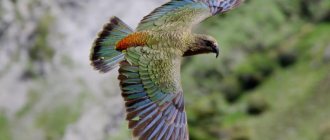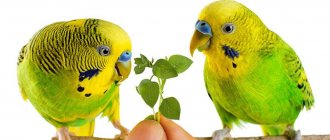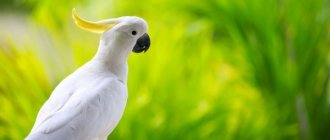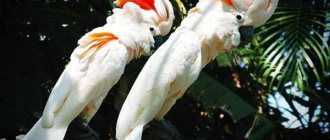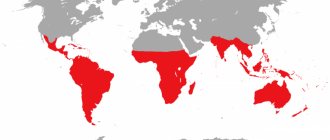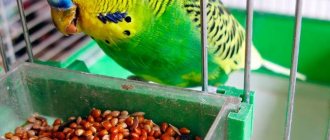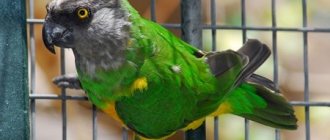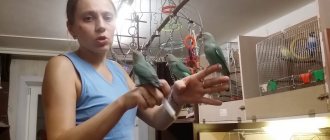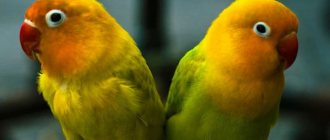- Wild animals
- >>
- Birds
The Hyacinth Macaw (Anodorhynchus hyacinthinus) is the largest flying parrot. Its length reaches one meter. It has a distinctive coloration, which determined the name of the species. It has a neat head, eyes framed by bright yellow circles, and has a large rounded beak. Has a developed intellect. Hears and recognizes human speech and natural sounds. It has been proven that the hyacinth macaw not only repeats human speech, but reproduces words quite meaningfully. Asks and answers questions, takes part in the conversation.
Origin of the species and description
Photo: Hyacinth Macaw
The hyacinth macaw belongs to the phylum Chordata, class of birds, order Psittaciniformes. One of two described species of the genus A. hyacinthinus.
Anodorhynchus hyacinthinus or the great hyacinth macaw was first described and sketched in detail by British ornithologist John Leithen in the late 18th century. An English naturalist described the bird based on a taxidermy specimen sent to England from the colonies. The first work describing a large blue bird with a prominent beak dates back to 1790 and is entitled Psittacus hyacinthinus.
Video: Hyacinth Macaw
The modern name of the largest flying parrot on the planet is Anodorhynchus hyacinthinus. Body length from head to tail is from 100 to 130 centimeters. The plumage is an amazing sapphire color. The head is small, neat, completely covered with small feathers. A spectacular ring around the eyes and a stripe framing the beak like a mustache of bright yellow color. The hyacinth macaw can be recognized by its long tail and large, powerful beak. Habitat: Brazil, Bolivia and Paraguay.
The second representative of the species, the small hyacinth macaw Anodorhynchus leari, was described by the nephew of Napoleon Bonaparte in the mid-19th century. Carl Bonaparte described the bird exactly a year before his own death.
Carl Bonaparte noted several differences between the first and second species of parrots. The Lesser Hyacinth Macaw has the same coloration, but the wings are slightly darker, and the head, chest and belly have a green tint. The main difference is the size and weight of the bird. The body length was 75 cm and the weight was 800 grams. Lives in hard-to-reach areas in North-East Brazil.
Tame a Giant
Thanks to its well-developed intellect, the macaw quickly gets used to people, it makes good contact and quite quickly understands the language the owner speaks. Over the course of several years of living in a family, the macaw learns to imitate the speech style of each member of its family and knows how to joke, answering questions or provoking a dialogue with a person on its own.
They became famous for their tenderness towards people and humane habits in their character. They are friendly in everyday life, excellent companions for adults and children of all ages. Thanks to the analysis of human speech, they can clearly distinguish who is addressing them and turn their heads towards the speaker.
The largest macaw studied weighed 1.8 kilograms.
Appearance and features
Photo: Hyacinth macaw parrot
Hyacinth macaws are the largest flying parrots in the world. With a weight of 800 grams to 1 kilogram, which is significant for birds, they are able to cover not very long distances. The bird leads a sedentary lifestyle. It does not migrate, does not change habitats, and remains in the traditional territories of its species all its life. However, in search of food, it can fly tens of kilometers, and then return to the nesting site at night.
Hyacinth macaws make their homes in the hollows of the Panama tree. The tree belongs to the malvaceae flowering family and has soft and pliable wood, which allows parrots to expand and deepen natural cavities. Parrots choose large and fairly comfortable recesses. If necessary, line the bottom of the hollow with dry leaves, sticks and feathers, which are found in the crowns of trees and on the ground. The nesting height can reach 40 meters above the ground.
Due to their large stature and keen intelligence, hyacinth macaws are called gentle giants. Parrots received this nickname for their ability to correctly use affectionate words. An intelligent bird speaks the languages of its owners, analyzes speech perfectly, enters into dialogues, and knows how to joke. The Blue Macaw is balanced and friendly, making a good companion.
The largest known hyacinth macaw in the world reached 1 meter in length. Its weight is 1.8 kg. Wing length 42 cm. The tail is long and pointed. The magnificent blue wings change color to a lighter tone at the ends. Neck color with a slight smoky tint.
Lifestyle
The hyacinth macaw parrot does not like noisy flocks. Birds live in groups of 10-12 individuals. Thanks to their impressive dimensions, they can fend for themselves in their natural environment. Departure from the nest occurs early in the morning.
In search of food, parrots can fly over distances of several tens of kilometers. The hot part of the day is spent in trees, hiding under their crown from the scorching rays of the sun.
They usually spend the night in the same place.
Where does the hyacinth macaw live?
Photo: Great Hyacinth Macaw
The hyacinth macaw lives in thinned, sparse and food-rich forests of South America. The original habitats are located in the jungle. This part of the forest is located along tropical rivers. Rich in fruits, berries and nuts. There is enough food here, tree branches serve as protection and at the same time there is enough space for flights.
Gentle giants can be found in large areas of Bolivia covered by a network of tropical rivers, for example, in the subtropical forests of the foothills. The traditional habitat of the hyacinth macaw is in the Amazon River basin, as well as in the swampy area of Pantanyal do Rio Negro.
There are three main known habitats in South America:
- the Pantanal tectonic basin in Brazil, adjacent eastern Bolivia and northeastern Paraguay;
- in the Cerrado region in eastern Brazil (Maranhao, Piaui, Bahia, Tocantins, Goiás, Mato Grosso, Mato Grosso do Sul and Minas Gerais);
- open areas along the Tocantins, Xingu, Tapajos rivers and Marajo Island in the eastern Amazon basin of Brazil.
Small populations are found in palm swamps, open woodlands and other semi-open wooded areas. The Hyacinth Macaw avoids dense, humid forests. These parrots are found in savannah meadows and dry thorny forests.
Habitat
In their natural environment, hyacinth macaws live in Latin America. These birds can sometimes be seen in the Amazon jungle of Brazil, as well as in Paraguay and Bolivia. The Lesser Hyacinth Macaw has a more limited habitat. These parrots can only be found in the Brazilian state of Bahia.
They nest in the hollows of tall trees. The chosen place of residence is:
- Palm groves or small areas of forest on river banks.
- Forest clearings on the outskirts of the forest, with lonely trees suitable for nesting.
What does the hyacinth macaw eat?
Photo: Hyacinth Blue Macaw
Much of the hyacinth macaw's diet is based on nuts from the local Acuri and Bokayuwa palms. Strong beaks are adapted for eating hard kernels of nuts and seeds. Blue parrots can even crack coconuts, large Brazil nuts and macadamia nuts.
The Great Blue Parrot's food preferences revolve around nuts. The hyacinth macaw's diet includes Brazil nuts, cashews, almonds and hazelnuts. Birds of this species have dry, rough tongues. They are adapted for peeling and extracting fruits.
The blue macaw is not averse to picking up the acuri nut. Despite the fact that this nut is excessively hard and in its fresh form is too much for a parrot, birds have adapted to look for it in the droppings of cattle. Smart birds fly to pastures specifically to feast on this nut.
In addition, they eat fruits and plant seeds. Don’t mind eating bakuri, mandakaru, pinyau, sapukai, peki, inga, cabasiña do campo, pitomba, buriti, karguata, white jabuticaba, guava, guarana and other fruits. In the Pantanal, hyacinths collect the nuts of the palms Acrocomia aculeata, Attalea phalerata and Acrocomia lasiospatha.
Nutrition
It was not in vain that nature awarded these birds with such a powerful beak. It is thanks to him that hyacinths obtain food for themselves in the wild. They eat all kinds of fruits, vegetables, and are not averse to eating nuts and seeds. The impact characteristics of the beak allow it to pierce the shell of even the hardest fruits.
When kept in captivity, it is advisable to keep the diet as close to natural as possible.
But in addition to the traditional nuts, seeds, fruits and vegetables for pets, you can give grain mixtures, dairy products and various biscuits.
Features of character and lifestyle
Photo: Hyacinth macaw bird
The Hyacinth Macaw forms pairs. Families gather in small flocks. This makes it easier to find food and care for the chicks. In search of food, parrots fly several kilometers away from their nests and always return back.
The Great Blue Parrot is a very curious bird that communicates with other representatives of the fauna of South America. Reproduces the sounds of wildlife and imitates other animals. In nature, life expectancy can reach 90 years.
It has a sharp, guttural whistle. He can wheeze, whistle and grumble. The sound made by the hyacinth macaw can travel several kilometers. This is how parrots warn of danger. Being in a good mood, they can communicate with their fellow tribesmen for a long time, walking or swinging on tree branches.
In captivity they listen to and understand music. They move to the beat, dance and make sounds to the beat of the music.
Birds have high intelligence. In captivity they show affection for their owners. They imitate speech. Understand words and commands. Parrots of this species are used as circus performers. They are touchy, remember bad treatment, get offended by lack of attention, get sad and lash out. Subject to stress. As a sign of protest or sadness, they may pluck their feathers and refuse to eat.
Instructions
In order to obtain this or that shade, you need to know the laws of color mixing. Although the human eye can distinguish hundreds of tones, in reality only three main colors can be distinguished, thanks to which the others are obtained. Red, blue and yellow are basic colors and cannot be created by mixing them. But when combined in different proportions and quantities, they can create any desired shade.
For example, from a combination of blue and yellow, green, blue and red are obtained; when mixed, they give a dark blue tint, and by combining equal parts of all three colors, you can get black. By experimenting with the amount of one color or another, you can endlessly obtain new shades. We should not forget that indiscriminate mixing of different dyes leads to the formation of dirty, unattractive colors.
- You should not mix more than three different colors, as this will result in a “dirty” shade.
- Some paints can react chemically with each other, causing a change in their saturation, lightness, or hue.
- Some watercolor paints, such as cobalt blue or cadmium red, lose their ability to cover the surface evenly when in contact with large amounts of water.
- Gouache paints often become lighter when dry. Also, you should not take them out of the can with a brush: wet bristles capture paint of varying thicknesses, and this subsequently causes unwanted streaks to form on the paper.
- It must be remembered that each color has an infinite number of shades, from cold to warm. Mixing one shade with another gives a completely new one.
- White paint, as a rule, softens colors, making them more delicate and blurry, while black paint, on the contrary, mutes and weighs down the color.
You can clearly see how to mix paints by looking at the color wheel, in which three basic simple colors are placed at equal distances from each other, with additional colors extending from them. This table clearly demonstrates the possibilities and consequences of mixing colors.
Social structure and reproduction
Photo: Hyacinth Macaws
Nesting time for the hyacinth macaw occurs from July to December. Parrots use ready-made tree hollows or rock crevices as nests.
In some ways, the hyacinth macaw is dependent on the toucan, which distributes the seeds of the manduwi tree - Sterculia apetala. This is what is most suitable for nesting. Its soft and pliable wood is suitable for expanding and enlarging nests. But unfortunately, the toucan is also responsible for eating the eggs of the hyacinth macaw.
Great blue parrots begin to mate at 7 years of age. Males court females, offering them the most delicious pieces of fruit and nuts, affectionately tugging at feathers and caressing them.
Courtship ends with mating and egg laying. There are no more than two of them in the clutch. As a rule, out of two chicks hatched, only one survives. The reason is that parrots lay eggs several days apart. The chicks hatch at the same intervals. The younger chick cannot compete with the older one in claims for food and, as a rule, dies from malnutrition.
Incubation lasts about 30 days. The male cares for the female while she incubates the eggs. About three months after incubation, the chicks leave the nest but remain dependent on their parents for up to six months.
Keeping at home
Not an easy pet to keep at home. Special conditions of detention are required. It is not enough to simply buy a cage for a large parrot. Gotta take the power of the beak into account, huh? hence? The bars of the grill should be as thick and strong as possible. Some owners believe that no matter how large the enclosure is, it is best to give such a pet a whole room. They need flights for their health. Be prepared for the fact that all the furniture and equipment in the apartment will suffer from the beak if you do not provide your pet with plenty of toys for natural destruction.
These winged friends themselves are distinguished by their gentle disposition and calm character. Very curious and intelligent creatures. Due to the rarity of this pet, the price of the hyacinth macaw is very, very high.
We recommend that future owners familiarize themselves with the following materials:
- How to organize feeding a parrot - detailed material on creating a varied and healthy diet, including grain mixture, cereals, fruits, vegetables, herbs and twig food.
- How to tame a parrot - a several-step technique based on the gradual formation of mutual trust between a person and a winged pet.
Natural enemies of hyacinth macaws
Photo: Great Hyacinth Macaw
In the wild, large blue parrots have a lot of enemies. First of all, these are predators from the order of birds. The parrot habitats include turkey vulture, yellow-headed cathart, king vulture, osprey, as well as cayenne and long-billed kites. Harpies, ospreys and more than 12 species of hawks are not averse to feasting on parrots.
Some birds actively hunt hyacinth parrots, while others are not averse to feasting on their eggs. Toucans and jays have been spotted destroying parrot nests. Sometimes wild cats, snakes and a large number of raccoons make raids on the masonry. Noses deftly climb trees and climb into nests. There are cases when they entered into fights with parrots over clutches.
Large and medium-sized tree snakes also hunt for more than just eggs and newborn brood. Among the most dangerous snakes are boa constrictor, anaconda, and lizards. Wild forest cats are not averse to feasting on parrots: ocelot, forest tiger cat and straw cat.
However, the main danger for the hyacinth parrot is humans. Beautiful feathers and a valuable beak make the hyacinth macaw a desirable prey. Its feathers are used to decorate accessories and to make souvenirs and amulets.
The hatched chicks are taken from the nests for further resale to private collectors and zoos. Due to its quiet and docile nature, the hyacinth macaw is a desirable acquisition. The blue parrot does not breed in captivity. Large parrots are affectionate and sociable creatures. Their ability to communicate and reproduce speech raises their price.
Indians of some tribes from southern and central Brazil use hyacinth parrot feathers for traditional headdresses and national jewelry.
In addition, birds suffer from loss of natural habitat. Selvas and tropical rainforests are disappearing as a result of human activity. Forests are cut down and burned. This is how people free up land for new farmland and industrial construction.
General characteristics
Speaking about our blue beauties, it is worth mentioning their wonderful beak. This organ performs many functions. We have already talked about the ability to crack the hardest nuts, what else?
General characteristics of a parrot
A parrot's beak is a full-fledged hand. Performs the following functions:
- tactile, tests surfaces for strength, safety, suitability for anything;
- defensive, there is nothing to say here, adult macaws have no natural enemies at all;
- manipulative, with the help of their beak and tongue, macaws can perform both rough work (for example, hollowing out a nest) and the finest operations (for example, grooming a partner);
- third point of support: macaws are excellent tree climbers, clinging alternately with their paws and beak, they can move in all directions along large and small branches.
It’s not for nothing that we mentioned nests - to breed their offspring, hyacinth macaws build hollows in wide trunks up to half a meter deep. Over time, they refine them, and the result is a fairly spacious house, covered with wood chips.
characteristics of the hyacinth parrot
Population and species status
Photo: Hyacinth macaw parrot
The hyacinth macaw is an endangered species due to black market trade, poaching and habitat loss. According to official data, about ten thousand birds were taken from the wild in the 1980s alone. About half were destined for the domestic Brazilian market.
In 1972, a Paraguayan dealer received 300 fledglings, only 3 birds survived. Hunting for young individuals has led to depletion of the population. The population is also affected by the disappearance of traditional habitats. The habitat is changing due to ranching and mechanized farming, as well as due to the construction of hydroelectric dams.
Annual grass fires started by farmers destroy parrot nesting sites. Bird nesting sites are no longer suitable for life and reproduction. In their place were plantations of vegetables, fruits and tobacco. Parrots belonging to the family Psittacidae are endangered. 46 out of 145 species are at risk of global extinction.
By the beginning of the 21st century, the number of large blue parrots did not exceed 3,000 individuals. The threatened situation of the species forced people to introduce urgent measures to preserve rare birds. Over the past two decades, the population has doubled to 6,400 individuals.
A Brief History of the Color Genetics of Budgerigars
Through long-term selection, at present, in the colors of budgerigars, there are about 32 primary mutations, which in turn give more than a hundred secondary ones. It took scientists many years so that today we can enjoy the incredible variety of colors of budgerigars. Thanks to the laws of inheritance, breeding a particular color now becomes possible even for ordinary bird lovers.
In 1872, as a result of long work, breeders managed to breed a yellow budgerigar. And only in 1878. Belgian scientists introduced the blue budgerigar to the world, but offspring of this color were obtained only in 1910.
Photo of a blue budgerigar:
Thanks to the blue wavy, dark blue and dark green parrots were born.
White budgerigars were bred in France in 1917, and 7 years later albinos appeared in Germany, and parrots of variegated colors appeared in Denmark. We owe the purple and brown colors to England.
Not mammoths, but also extinct
Today, many species of macaws have become extinct, for example, the Virginia macaw, the red Jamaican macaw, the Guadeloupe macaw, the Martinique macaw, and the Cuban macaw.
We have only reached a description of the yellow-green Dominican macaw, which the inhabitants of the island of Haiti ate until the 17th century. The Virginia Macaw ceased to exist much earlier. The reason for its disappearance has not been precisely established, since it disappeared in the 3rd century. Only his paws remained as a keepsake, like fossils among other finds from the kitchen of primitive man.
Its neighbor from Cuba lasted much longer, presumably existing until 1885. But the fertile land of the island did not go unnoticed by the settlers. The cultural development of the tropical forest implied its destruction. In return, more profitable coffee and banana trees were planted.
About the abilities of human speech
All described species of parrots are not unique in their ability to reproduce human speech. They are not always trainable, although these birds are considered very smart and intellectually developed. At best, they manage to master 20-30 words in the human language. But birds use them very appropriately. Therefore, it seems that the parrot understands what is being discussed in the conversation.
To maintain a conversation, it does not matter whether it is a female or a male. Both genders have the same abilities. But age plays an important role. Young people learn much faster. It is better to start training with chicks at 4-5 months.
These birds have no equal in reproducing various sounds. They imitate the barking of a dog or the meow of a cat so closely that they can easily mislead you. Aerobatics is the creaking of a door or the cough of a cold owner.
Future color of the offspring of budgerigars
In order to at least slightly predict the color options of the chicks from your pair, you need to determine what the main color of your wavy is.
Green parrots have a natural base color of yellow. Blue parrots have white.
There is also a Parblue species between the Green and Blue rows of parrots - these are the Yellow-faced and Golden-faced parrots.
The color of green budgies is dominant during breeding.
Parblues are dominant to Blue parrots, but recessive to Green parrots.
Blue budgies are recessive to other colors.
Interestingly, the part of the spectrum in which parrots see each other is ultraviolet and their colors are much brighter than a person can see. Moreover, if you look through the eyes of a parrot at another budgerigar, you can see that the radiance of the bird is provided not only by the color of the plumage, but also by the wax and paws, which are cast in an azure color. The budgerigar's cap also attracts the eye with its unusual shine.
During mating and courtship, birds try to show themselves in all their glory. The brightness of the male's plumage plays a decisive role for the female.
Lifespan
Despite the rather aggressive nature of some individuals, the hyacinth macaw is easily tamed and gets along well with people. It can often be seen in zoos and among pet lovers. The maximum lifespan of this bird is 39 years. There is some undocumented information about the 54-year-old individual.
However, it is certain that some danger hangs over the largest parrot on earth. For centuries, this bird has caused indescribable delight in humans. In nature, the population of this species of parrot continues to decline, as amazing birds constantly have to face considerable difficulties.
general information
You will probably remember the appearance of this bird for a long time. The length of its body can reach as much as sixty centimeters. And the weight is four hundred grams. However, what makes it noticeable is not its significant body dimensions, which differ from the size of most domesticated pets, but its incredibly beautiful blue plumage, which is absent only on the front part of the bird.
Another interesting feature characteristic only of young individuals of the blue macaw photo, which can be seen on our website, is a light stripe exactly in the middle of their beak. However, with age it disappears, and the beak becomes uniformly dark. However, you are unlikely to be able to remember at least one species of bird that would have the same interesting feature.
How to effectively combine yellow and blue (blue) in clothes?
“Is it possible to combine such opposite things in one ensemble?!” - you ask. In fact, it is not only possible, but also necessary! Think of it this way: the combination of blue and yellow shades is like the bright sun on a cloudless sky. And everything that is dictated by nature itself is perfect and doomed to success.
If you took a muted yellow, then blue should also be used in the same way, and vice versa, if the light tone is chosen to be warm, then the dark one should match and be no less saturated. Everything will turn out well, the main thing is not to overdo it!
Classic style
The office dress code dictates its own rules that must be obeyed. But it should be done exclusively beautifully and attractively.
For a professional look, consider dark shades of blue and muted yellow.
You can opt for a mustard blouse and an ultramarine or sapphire skirt, or wear a lemon dress and throw a cobalt jacket over your shoulders. You definitely won’t go unnoticed, but you won’t raise any unnecessary questions either.
Romantic
To go on a date or meet with friends, you can use, on the contrary, light and airy colors. For example, an elegant azure sundress with a thin yellow belt and matching earrings will create the effect of an inspired and gentle person, which will definitely affect your image in the best way.
Examples of successful combinations in the photo.
Try on sky-colored trousers with a flowy beige-yellow blouse. And if you dilute the look with a couple of interesting accessories, for example, a sunny handbag or a thin blue bracelet, then all eyes will definitely be turned only to you!
In autumn, you can take a closer look at bright outerwear.
Sports
Such an image simply requires fiery colors. In order not to overdo it, use the 1/3 rule: in a bright set, make one of the colors the main one, and add the second as details in the specified proportion.
For example, classic blue jeans, a sweatshirt a shade lighter and a yellow raincoat (or jacket).
Don’t be afraid to play with flowers, because with their help you can lift your mood and provide a good boost of energy.
Free street style removes all barriers. Any experiments are possible here.
Evening dress
Deep blue seems to be created for social events and expensive parties. Just think about a long dress in this color...
But how can you beat yellow here? The answer is simple - pay attention to jewelry, use gold
A lace dress looks elegant.
This could be rich embroidery, an elegant sparkling clutch or a belt framing your waist, or golden shoes. One thing is for sure: in this form, you can even walk along the red carpet to non-stop applause!
Stand out in style! Add variety and bright colors to your wardrobe, and then have fun mixing them into one outfit. Rest assured, you will definitely like it!
Heard from afar
Parrots of the genus Hyacinthidae deserve a more detailed description, because among them there are species of very different sizes with the same color of feathers. The smaller species is called “small”. And “big” is the name given to the largest individuals in the world, which, together with their tail, reach a length of one meter.
The comparison with hyacinth is not accidental, since the plumage of parrots literally shines with the bright, saturated tones of a very common and well-known flower. This color is sometimes called cobalt after the element that has been used since ancient times to color glass blue.
Both small and large birds have eyes framed by patches of bright yellow skin without feathers. Gray paws and dark brown irises are distinctive features of the hyacinth genus. In addition, all individuals have a shrill, creaky voice, which at times turns into wheezing or squealing. The sound produced is so strong that it can be heard even a kilometer away.
Behavior
Blue-and-yellow macaws lead a sedentary lifestyle. They live in areas with tropical and subtropical climates, where there is plenty of food all year round, so migrations are very rare.
Activity occurs mainly in the morning and afternoon hours. Several hundred birds often gather together to feed and roost together.
Parrots feed in the crowns of trees, where they are difficult to see. They fly well, but relatively slowly. If necessary, they can cover a distance of up to 25 km during the day, returning to their roosting places after sunset.
During rest, pairs sit close to each other, engage in mutual cleaning of their plumage and periodically make guttural sounds. They communicate with each other in soft and pleasant voices, and in an irritated state they switch to a loud cry, reminiscent of a drawn-out “ra”.
Differ in tail length
In the countries of South America, located in the Amazonian lowland and in the foothills of the Andes, the red macaw lives. In Mexico it is called guacomaya - Mayan parrot. This is one of the largest representatives of the genus. The size, including the tail, almost reaches a meter. In this case, the tail itself can be 2/3 of the total length. The red macaw lives up to its name. It is this color that covers most of the bird's body - the neck, back, head and chest. A yellow stripe runs like a bright ribbon along the scarlet wings.
The green-winged macaw is very similar to this parrot. But there are differences. First, there is no yellow stripe on the wings, but there are green and blue feathers. The second tail does not exceed half the length of the body, the maximum length of which is 45 cm. The green-winged macaw, like its fellow, weighs approximately 1.7 kg.
These birds live next door. Mexico, Nicaragua, Panama, Peru, Colombia, Venezuela are the domains of the Mayan parrot. Ecuador, Brazil, Argentina, Paraguay, Bolivia are the countries chosen by the green-winged macaw. Any of these species can be found in the domain of another.
